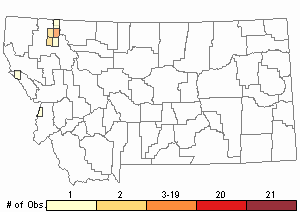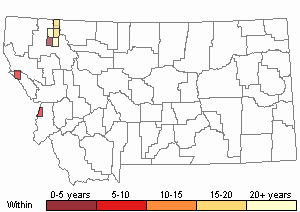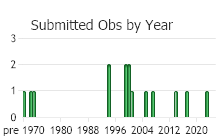View in other NatureServe Network Field Guides
NatureServe
Montana
Utah
Wyoming
Idaho
Wisconsin
British Columbia
South Carolina
Yukon
California
New York
Velvetleaf Huckleberry - Vaccinium myrtilloides
State Rank Reason (see State Rank above)
Only known in Montana from several sites in the vicinity of West Glacier. Some of the known population and associated habitat has been negatively impacted by development (visitor and transportation facilities) within Glacier National Park.
General Description
Clonal, intricately-branched shrubs to 45 cm. Stems terete, hirsute with small, white blisters, reddish to brownish; foliage buds small, acuminate with 4 scales; floral buds larger, rotund, of 6 to 8 scales. Leaves to 40 mm long; blades elliptic, hirsute, at least on the veins, margins entire, ciliate. Inflorescence crowded, few-flowered racemes borne from distal floral buds on last year’s stem. Flowers calyx lobes deltoid; corolla cylindrical bell-shaped, to 5 mm long, pale yellow to greenish-white often with narrow, reddish stripes. Berry blue, to ca. 9 mm broad; calyx lobes persistent on summit of berry (Stickney in
Lesica et al. 2012. Manual of Montana Vascular Plants. BRIT Press. Fort Worth, TX).
Phenology
Flowering in mid-June, fruit mature in mid-August.
Diagnostic Characteristics
This Vaccinium is the only one in our area that has hairy twigs and leaves.
Species Range
Montana Range
Range Descriptions

 Native
Native
Range Comments
Boreal North America, south to WA, northwestern MT, IA, and VA. Peripheral.
Observations in Montana Natural Heritage Program Database
Number of Observations: 27
(Click on the following maps and charts to see full sized version)
Map Help and Descriptions
Relative Density

Recency



 (Observations spanning multiple months or years are excluded from time charts)
(Observations spanning multiple months or years are excluded from time charts)
Habitat
Moist to rather dry forests in the montane zone.
Ecological Systems Associated with this Species
Ecology
POLLINATORS The following animal species have been reported as pollinators of this plant species or its genus where their geographic ranges overlap:
Bombus vagans,
Bombus appositus,
Bombus centralis,
Bombus fervidus,
Bombus flavifrons,
Bombus frigidus,
Bombus melanopygus,
Bombus mixtus,
Bombus nevadensis,
Bombus rufocinctus,
Bombus ternarius,
Bombus sitkensis,
Bombus occidentalis,
Bombus pensylvanicus,
Bombus bimaculatus,
Bombus griseocollis,
Bombus impatiens,
Bombus insularis,
Bombus bohemicus, and
Bombus flavidus (Heinrich 1976, Thorp et al. 1983, MacKenzie and Averill 1995, Stubbs and Drummond 2001, Ratti et al. 2008, Colla and Dumesh 2010, Colla and Ratti 2010, Colla et al. 2011, Williams et al. 2014).
Stewardship Responsibility
Threats or Limiting Factors
STATE THREAT SCORE REASON
Reported threats to Montana's populations of Velvetleaf Huckleberry include residential and commercial development, and logging (MTNHP Threat Assessment 2021). Most populations occur in Glacier National Park (GNP), where population damage has occurred following a visitor center development. Facility expansion and maintenance pose a potential risk to populations in the future. Few populations occur outside of GNP, where its habitat is exposed to logging activities and development.
References
- Literature Cited AboveLegend:
 View Online Publication
View Online Publication Colla, S., L. Richardson, and P. Williams. 2011. Bumble bees of the eastern United States. Washington, DC: USDA Forest Service, Pollinator Partnership. 103 p.
Colla, S., L. Richardson, and P. Williams. 2011. Bumble bees of the eastern United States. Washington, DC: USDA Forest Service, Pollinator Partnership. 103 p. Colla, S.R. and C.M. Ratti. 2010. Evidence for the decline of the western bumble bee (Bombus occidentalis Greene) in British Columbia. Pan-Pacific Entomologist 86(2): 32-34.
Colla, S.R. and C.M. Ratti. 2010. Evidence for the decline of the western bumble bee (Bombus occidentalis Greene) in British Columbia. Pan-Pacific Entomologist 86(2): 32-34. Colla, S.R. and S. Dumesh. 2010. The bumble bees of southern Ontario: notes on natural history and distribution. Journal of the Entomological Society of Ontario 141:39-68.
Colla, S.R. and S. Dumesh. 2010. The bumble bees of southern Ontario: notes on natural history and distribution. Journal of the Entomological Society of Ontario 141:39-68. Lesica, P., M.T. Lavin, and P.F. Stickney. 2012. Manual of Montana Vascular Plants. Fort Worth, TX: BRIT Press. viii + 771 p.
Lesica, P., M.T. Lavin, and P.F. Stickney. 2012. Manual of Montana Vascular Plants. Fort Worth, TX: BRIT Press. viii + 771 p. MacKenzie, K.E. and A. L. Averill. 1995. Bee (Hymenoptera: Apoidea) diversity and abundance on cranberry in southeastern Massachusetts. Annals of the Entomological Society of America 88(3): 334-341.
MacKenzie, K.E. and A. L. Averill. 1995. Bee (Hymenoptera: Apoidea) diversity and abundance on cranberry in southeastern Massachusetts. Annals of the Entomological Society of America 88(3): 334-341. MTNHP Threat Assessment. 2021. State Threat Score Assignment and Assessment of Reported Threats from 2006 to 2021 for State-listed Vascular Plants. Botany Program, Montana Natural Heritage Program, Helena, Montana.
MTNHP Threat Assessment. 2021. State Threat Score Assignment and Assessment of Reported Threats from 2006 to 2021 for State-listed Vascular Plants. Botany Program, Montana Natural Heritage Program, Helena, Montana. Ratti, C.M., H.A. Higo, T.L. Griswold, and M.L. Winston. 2008. Bumble bees influence berry size in comercial Vaccinium spp. cultivation in British Columbia. Canadian Entomologist 140(3): 348-363.
Ratti, C.M., H.A. Higo, T.L. Griswold, and M.L. Winston. 2008. Bumble bees influence berry size in comercial Vaccinium spp. cultivation in British Columbia. Canadian Entomologist 140(3): 348-363. Stubbs, C.S. and F.A. Drummond. 2001. Bombus impatiens (Hymenoptera: Apidae): an alternative to Apis mellifera (Hymenoptera: Apidae) for lowbush blueberry pollination. Journal of Economic Entomology 94:609-616.
Stubbs, C.S. and F.A. Drummond. 2001. Bombus impatiens (Hymenoptera: Apidae): an alternative to Apis mellifera (Hymenoptera: Apidae) for lowbush blueberry pollination. Journal of Economic Entomology 94:609-616. Thorp, R.W., D.S. Horning, and L.L. Dunning. 1983. Bumble bees and cuckoo bumble bees of California (Hymenoptera: Apidae). Bulletin of the California Insect Survey 23:1-79.
Thorp, R.W., D.S. Horning, and L.L. Dunning. 1983. Bumble bees and cuckoo bumble bees of California (Hymenoptera: Apidae). Bulletin of the California Insect Survey 23:1-79. Williams, P., R. Thorp, L. Richardson, and S. Colla. 2014. Bumble Bees of North America. Princeton, NJ: Princeton University Press. 208 p.
Williams, P., R. Thorp, L. Richardson, and S. Colla. 2014. Bumble Bees of North America. Princeton, NJ: Princeton University Press. 208 p.
- Additional ReferencesLegend:
 View Online Publication
View Online Publication
Do you know of a citation we're missing? Camp, W. H. 1945. The North American Blueberries with notes on Other Groups of Vacciniaceae. Brittonia 5(3):203-275.
Camp, W. H. 1945. The North American Blueberries with notes on Other Groups of Vacciniaceae. Brittonia 5(3):203-275. Jones, W. W. 1901. Preliminary flora of Gallatin County. M.S. Thesis. Bozeman, MT: Montana State College. 78 pp.
Jones, W. W. 1901. Preliminary flora of Gallatin County. M.S. Thesis. Bozeman, MT: Montana State College. 78 pp. Lesica, P., M.T. Lavin, and P.F. Stickney. 2022. Manual of Montana Vascular Plants, Second Edition. Fort Worth, TX: BRIT Press. viii + 779 p.
Lesica, P., M.T. Lavin, and P.F. Stickney. 2022. Manual of Montana Vascular Plants, Second Edition. Fort Worth, TX: BRIT Press. viii + 779 p. Martin, P.A. 1979. Productivity and taxonomy of the Vaccinium globulare, V. membranaceum complex in western Montana. M.S. thesis. University of Montana, Missoula. 136 pp.
Martin, P.A. 1979. Productivity and taxonomy of the Vaccinium globulare, V. membranaceum complex in western Montana. M.S. thesis. University of Montana, Missoula. 136 pp.
- Web Search Engines for Articles on "Velvetleaf Huckleberry"





